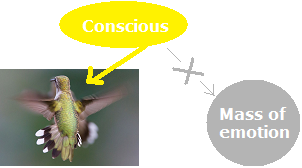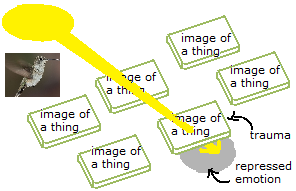The Kuriki method (the first edition in 2007) is a theory about Tourette’s syndrome (tic disorder) and obsessive-compulsive disorder to cure these diseases without medication. This theory is based on the author’s inference and interpretation regarding the structure of these diseases. This theory is based on the author’s inference and interpretation regarding the structure of these diseases. Since it has been written for the psychoanalysts, reading will be difficult for people in general and it might be sometimes read erroneously. Therefore the Kuriki method must presuppose that the patient is treated by a nearby psychoanalyst, and that, between the patient and the Kuriki method, there is always the psychoanalyst. The explosion of emotional catharsis, which has strong repercussions, is done only for three seconds, once a week: beyond this rhythm, it would be an accident caused by negligence, and the psychoanalyst who is inexperienced in emotional catharsis must take responsibility for the temporary mental collapse caused by the accident. Also, to the patient who has weak capacity of logical reasoning, the psychoanalyst must explain well on the violent emotion of revenge caused by the illusory confusion between the person of the traumatic image in his head and the person in the real world.
Cure for Tourette’s syndrome (tic disorder) and OCD without medication
§21

§21
Abreaction
Awareness of a repressed emotion is called abreaction. Children who are not neurotic do all the time spontaneous abreactions naturally. Children in good health do natural repressions and natural abreactions. Neurotic children are deprived of natural abreactions. The photo above is a hummingbird. The hovering obliges the hummingbird to beat its wings continuously. The hummingbird stays as an object of the Conscious and blocks natural abreactions of the mass of emotion. The hummingbird draws attention of the Conscious. The tic moves constantly in the intentionality of the Conscious to the mass of emotion in order to impede accidental abreactions.
The upper layer of the structure of tic disorder
In the upper layer of the structure of tic disorder, objects of repression are bodily sensations. The hummingbird, that is to say, the « compulsive intramuscular sensation » of tic disorder, flies to impede natural abreactions of disagreeable bodily sensations: such as a chair, which is too hard, the tired legs, etc.
During sleep.
The Conscious is sleeping, so there is no abreaction, and the « compulsive intramuscular sensation » of tic disorder is not necessary for the repression function. Even if there is the « compulsive intramuscular sensation » of tic disorder, amplification can not be done by the Conscious. Also rationalizations will not be received. As the tic movements are conscious voluntary movements, tic movements are not possible during sleep.
Breathing is a voluntary automatic movement, which is done automatically during sleep. Breathing of dolphins are not automatic, and anesthesia causes a suffocation to them. When dolphins sleep, the left brain and the right brain sleep alternately.
The lower layer of the structure of tic disorder.
Neurotic persons have a very strong repression, and the awarenesses of the disagreeable judgement cannot be done naturally. An enormous mass of emotion will be formed, and intentional awarenesses of the repressed object will be needed in therapeutic purpose. The object of abreaction, that is to say, the repressed object is the disagreeable judgement that is hiding behind the image of the psychological trauma. The image of psychological trauma is the image of a very personal thing that the patient himself must seek; otherwise the parents of the child, if the child is very small. The psychoanalyst or the therapist should not pronounce his or her speculation. Therapists who pronounce immediately the countertransference are not suitable for the treatments.
When the patient has found the direction of the image of the trauma, the indices, which have been found once, will not flee, and there is no need to rush. If the thing of the psychological trauma has been found, the treatment of tic is to do small emotional catharses. This is to express the disagreeable judgment, which is hiding behind the image, with disagreeable emotion, but as the mass of emotion is enormous, abreactions should be done little by little. Once a week, just for three seconds. The psychoanalyst takes care of the braking of abreaction and big explosion of catharses is prohibited.
Children do not do emotional catharses. The parents find the thing of the psychological trauma and explain it to the child with words. In doing so, the child does not need to fully understand the verbal explanation. The fact that the traumatic image was verbalized is important. It is rather better to understand vaguely and progressively at his or her own pace. In addition, while drawings by the child are very useful for searching the trauma, explanations about the traumatic image with drawings by the adults are noxious. Explanations about the image with images are not expressions of the trauma in the mode of the Conscious, i.e., in the mode of words.
The abreaction will not be done all at once like opening wide the lid of a box. The bad therapists who want to show their ability to heal at once on the spot mental illnesses are amateurs ignorant of danger.
“Now, I’ll show you how I can heal this child immediately.”
The parents of the child should not require the immediate healing. Abreaction is the extraction of a real big mass.
Disagreeable things, and disagreeable émotions that are due to them.
As previously mentioned, “repression of disagreeable emotion” is a contradictory term in the descriptions of the Kuriki method: with repression, disagreeable things are not disagreeable. So, here, disagreeable emotions mean emotions that should be disagreeable, if they were not repressed. It is just this contradiction that is a big burden for the Unconscious of the patient. Healthy repression is an essential function for mental activity in peace and appropriate for each situation. If the function of repression is low, the mental activity in healthy illusions with a strong desire and happiness will be difficult. There are two sorts of disagreeable things. However, of course, as psychoanalysis, these things are sexually disagreeable, genitally disagreeable, that is to say, in the primitive bodily domain. Psychoanalysis is a therapy for bodily symptoms of hysteria.
Disagreeable things A; things that are not disagreeable in the Conscious: disagreeable emotions will be entirely repressed.
Disagreeable things B; things that are considered as disagreeable in the Conscious: disagreeable emotions will be partially repressed.
Disagreeable emotions have a quantitative attribute.
In healthy repressions,
Disagreeable things A; with natural abreaction, disagreeable things will be gradually considered as disagreeable and the disagreeable emotions will be gradually expressed in the Conscious.
Disagreeable things B; with natural abreaction, all disagreeable emotions will be gradually expressed in the Conscious.
In Freud’s psychoanalysis, abreaction is to express the repressed thing and the repressed emotion with words. In the Kuriki method, which is a therapy for tic disorder, the verbalization is not sufficient as an abreaction. For the abreaction as treatment of tic disorder, the bodily expression of the repressed emotion, i. e., the emotional catharsis is needed. In all cases, the expression with words in the Conscious is necessary for the therapeutic abreaction and the natural abreaction. Repression is a state in which the non-verbalized emotion is not in the Conscious. Many patients with Asperger syndrome have a tic disorder. The symptom of the difficulty to understand non-verbalized feelings is a kind of state of repression, and natural abreaction might be difficult.
Often people illogically say that there are two types of tic disorder; transient tic and chronic tic, etc., but in fact there is only one tic disorder, the rapidity of healing of which varies with the individual difference of each patient in the tendency of the natural abréaction. If a tic disorder disappears quickly with natural abreaction, it is a transient tic disorder.

